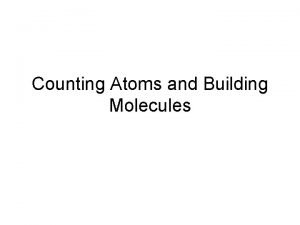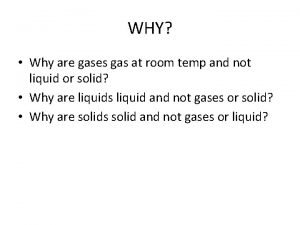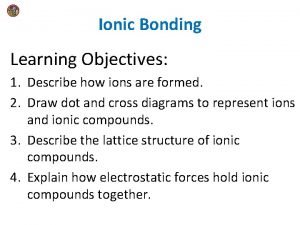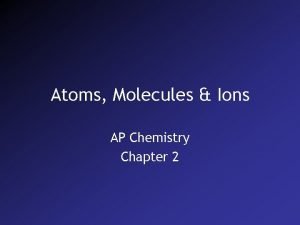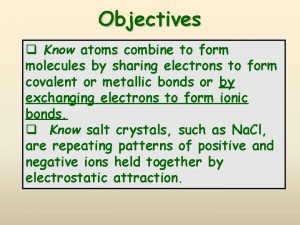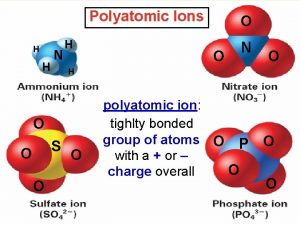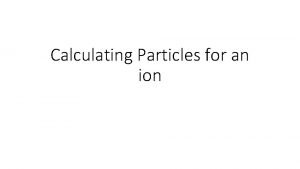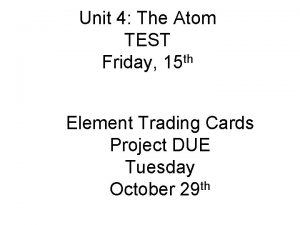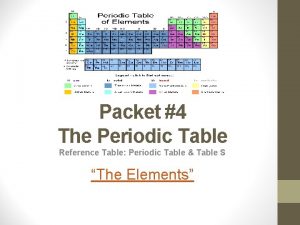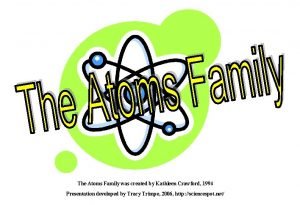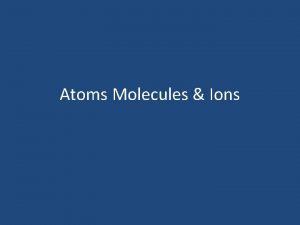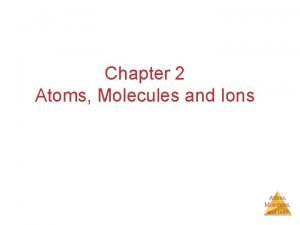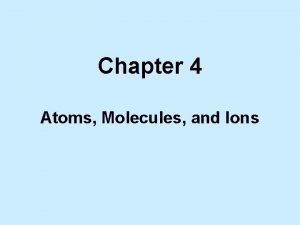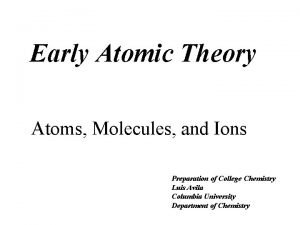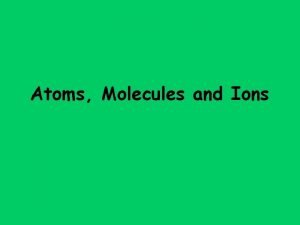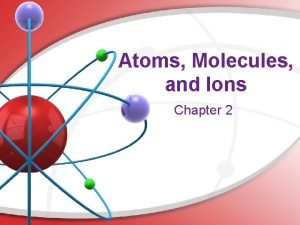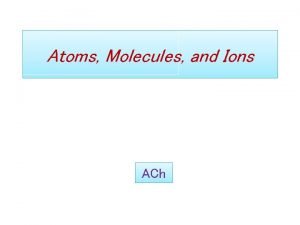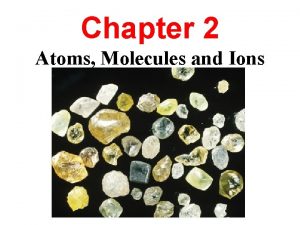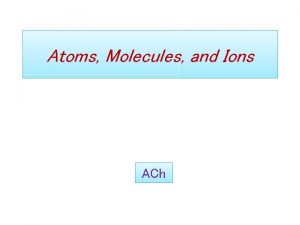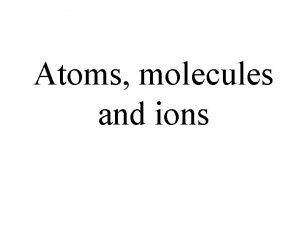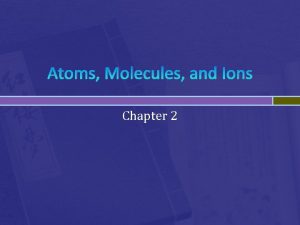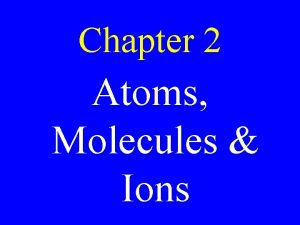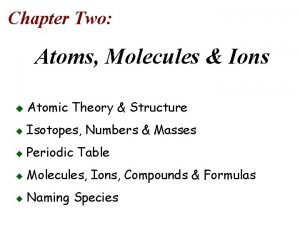Atoms Molecules and Ions The Atomic Theory The






















- Slides: 22

Atoms, Molecules, and Ions

The Atomic Theory The Greek Philosopher Democritus expressed the belief that all matter consists of tiny, indivisible particles. He named these particles atomos, which means indivisible. In 1808, John Dalton formulated a definition of the atom and thus Dalton’s Atomic theory says this: 1) Elements are made up of extremely small particles called atoms. All atoms of a given element are identical having the same mass, size, and chemical properties; however, the atoms of differing elements are different. 2) Compounds are composed of atoms of more than one element and in any compound the ratio of the number of atoms of any two elements present is an integer or simple fraction. 3) A chemical reaction involves the separation, combination, or rearrangement of atoms, however atoms are not created or destroyed in any chemical reaction.

The Structure of the Atom According to Dalton’s atomic theory, an atom is the basic unit of an element that can enter into a chemical reaction. Dalton believed that the atom was extremely small and indivisible, however it was later found that the atom actually posses internal structure and is made up of even smaller particles called subatomic particles, mainly electrons protons and neutrons.

Radiation is the study of the emission and transmission of energy through space in the form of waves. The cathode ray tube was used to study this phenomenon. It is a glass tube from which most of the air has been evacuated. Two metal plates are connected to a high voltage source and the negatively charged plate called the cathode emits an invisible ray. This cathode ray is drawn to the positively charged plate called the anode, where it passes through a hole where it strikes a special surface and produces a bright light. When a magnet and two electrically charged plates are added to the outside of the cathode ray tube, the direction of the ray can be controlled. According to electromagnetic theory, a moving charged body behaves like a magnet and can interact with electric and magnetic fields. So the ray, as a moving charged body, is affected by the electric filed of the two oppositely charged plates and the magnetic filed of the magnet. The cathode ray is attracted to the positive plate and repelled by the negative plate, so it must consist of negatively charged particles called electrons.

Cathode Ray Tube

Becquerel, a French physicist discovered that when he exposed thickly wrapped photographic plates to a certain uranium compound, it caused them to darken. In fact he had found that the radioactivity, or spontaneous emission of particles or radiation cause the plated to darken. There are three types of rays that are produced by the decay of radioactive substances as uranium. Alpha rays are positively charges particles called alpha( ) particles. Beta rays are electrons called beta( ) particles. Gamma rays are high energy rays otherwise known as gamma( ) rays.

In the 1900 s Thomson proposed that an atom is essentially a charged positive sphere with electrons embedded in it. In 1910, Rutherford carried out experiments in which he targeted alpha particles at thin foils of gold as seen in Figure 2. He noticed that most of the particles penetrated the foil with no or small deflection. However, he also noticed that occasionally an alpha particle bounced back. Based on these findings, Rutherford developed a new model of the atom in which most of the atom is empty space. The atom’s positive charges, called protons are concentrated in the nucleus, the dense central core of the atom. The charge of the proton is equal to the charge of the electron except it is positive. The mass of the proton is 1. 67262*10 24 g. , 1840 times bigger than the mass of the electron. Also, while typical atomic radius is 1 pm, the atomic nucleus is only 5*10 3 pm.

Rutherford Experiment

Atomic Number, Mass Number, and Isotopes Atoms can be identified by the number of protons and neutrons they contain. The atomic number, Z, is the number of protons in the nucleus of each atom of an element. Atoms with no charge have the same number of electrons as protons. An atom with an atomic number of seven has seven protons as well as seven electrons and is identified as the element nitrogen. The mass number, A, is the total number of neutrons and protons present in the nucleus of an atom of an element. The mass number is equal to the number of protons plus the number of neutrons.

Atoms of an element often have isotopes atoms that have the same atomic number but different mass numbers. The mass number, A, of an element, X, is written in the upper left hand corner of the element as such: AX. The atomic number of an element, Z, is written in the lower left hand corner of the element, X, as such: ZX. Since the chemical properties of an element are determined mostly by the protons and electrons in its atoms, isotopes of the same element have similar chemistries.

The Periodic Table The periodic table is a chart in which elements having similar chemical and physical properties are grouped together. It was made from the need to organize large amounts of information about the structure and properties of elemental substances. Thus, elements are grouped according to similar physical and chemical behavior. Figure 3 shows the periodic table of the elements. The elements are arranged by atomic number in horizontal rows called periods and in vertical columns known as groups or families, according to their similarities in chemical properties.

The elements are divided into metals, nonmetals, and metalloids. Metals are good conductors of heat and electricity. Nonmetals are poor conductors of heat and electricity. Metalloids have properties that are intermediate between those of metals and nonmetals. The elements change from metallic to nonmetallic as you go across the table left to right. Elements can be referred to collectively by their group number such as 2 A or special names that the groups have been give. Group 1 A elements are called alkali metals, group 2 A elements are called alkaline earth metals, group 7 A elements are known as halogens, and group 8 A elements are called noble gasses. We can make easy use of the periodic table to predict chemical behavior between elements.

Periodic Table

Molecules and Ions A molecule is an aggregate of at least two atoms in a definite arrangement held together by chemical bonds. The molecule may contain atoms of the same element or atoms of different elements. Molecules are not always compounds, which are made up of two or more elements. Molecules that contain more than two atoms are called polyatomic molecules. Ammonia, NH 3 is a polyatomic molecule as well as is ozone, O 3.

An ion is an atom or a group of atoms hat has a net positive or negative charge. The number of protons in the nucleus of an atom always remains the same during ordinary chemical reactions, however electrons may be gained or lost by certain elements. A cation is an ion with a positive charge resulting from the loss of electrons. Sodium, Na, can lose an electron to become sodium cation, Na+. An anion is an ion with a negative charge resulting from the gain of electrons. Chlorine, Cl, can gain an electron to become a chlorine anion, Cl. Together sodium and chlorine can combine to form sodium chloride, table salt. This type of reaction is called an ionic compound because it is formed from two ions. Monatomic ions are ions that form from only one element such as Na+. Polyatomic ions are ions that form from more than one element such as OH.

Chemical Formulas Chemists make use of chemical formulas to express the composition of molecules ad ionic compounds in terms of chemical symbols. A molecular formula shows the exact number of atoms of each element in the smallest unit of a substance. So H 2 is the molecular formula for hydrogen and H 2 O is the molecular formula for water. An allotrope is one of two or more distinct forms of an element. O 2 and O 3 are allotropes of oxygen since they are two different forms of the same element, oxygen.

Since molecules are too small for us to observe directly, we can use molecular models to observe them physically. In ball and stick models the atoms are represented by plastic or wooden balls with holes in them. Sticks or springs are used to represent chemical bonds. The angles of these bonds approximate the bond angles in actual molecules. Except for the hydrogen atom, the balls are the same size and each atom is represented with a different color. In space filling models, atoms are represented by truncated balls held together by snap fasteners. The bonds are not visible. Figure 4 shows a ball and stick model of a molecule on top and a space filling model of the same molecule on the bottom. The structural formula shows how atoms are bonded to one another in a molecule. In a water molecule, two hydrogen atoms are bonded to oxygen so its structural formula would be written as H O H. The lines connecting the two atomic symbols represent chemical bonds.

The empirical formula tells which elements are present and the simplest whole number ration of their atoms. The molecular formula for hydrogen peroxide is H 2 O 2. The ratio of H to O is 2: 2 or in simplest whole number terms 1: 1. Thus, the empirical formula for H 2 O 2 is HO. The empirical formula for N 2 H 4 is NH 2. Empirical formulas are the simplest chemical formulas while molecular formulas are the true formulas of molecules. Determining a compounds empirical formula is the first step in determining its molecular formula through experimentation. For water, H 2 O, its ratio of elements cannot be reduced further, so it is already an empirical formula as well as a molecular formula.

Naming Compounds Except for the ammonium ion, most cations are derived from metal ions. Metal cations are named simply by naming the metal and adding the word ion after it. So sodium in its ionic state would be named sodium ion. Aluminum in its ionic state would be named aluminum ion. For ionic compounds formed from just two elements, these are referred to as binary compounds. In binary compounds the first element named is the metal cation, followed by the nonmetallic anion. The anion is named by taking the first part of the element name and adding “ide” to the end. So chlorine would be called chloride and bromine would be called bromide. So the binary compound Na. Cl would be called sodium chloride. Certain anions such as hydroxide, OH and cyanide, CN also use the “ide” ending. So the compound Li. OH is called lithium hydroxide. This compound consists of three elements and so is called a ternary compound.

Molecular compounds are usually made up of nonmetallic elements. Many molecular compounds are binary and naming these compounds is similar to naming binary compounds. The first element is named and then the second element is named by adding “ide” to the end of the name. So HCl would be named hydrogen chloride and HBr would be named hydrogen bromide. When one pair of elements forms more than one compound, Greek prefixes are used to denote the number of each element present. The Greek prefixes can be seen below: Prefix Meaning Mono 1 Di 2 Tri 3 Tetra 4 Penta 5 Hexa 6 Hepta 7 Octa 8 Nona 9 Deca 10

An acid is a substance that yields hydrogen ions, H+, when dissolved in water. Acids contain hydrogen atoms and an anionic group. If the anionic group ends in “ide”, then acids are formed with a “hydro” prefix and an “ic” ending. HCl is called hydrogen chloride in the gaseous or liquid state. However, when HCl is dissolved in water, H+ ions are released and the molecule becomes hydrochloric acid. A base is a substance that yields hydroxide ions, OH , when dissolved in water. Na. OH, KOH, and Ba(OH)2 are all bases. Ammonia, NH 3 does not even contain an OH however, when it dissolves in water, it reacts with water to yield among other products OH ions. So it is indeed a base.

Hydrates are compounds that have a specific number of water molecules attached to them. Copper(II) sulfate has five water molecules attached to it, so the systematic name for the compound is copper(II) sulfate pentahydrate. Its formula is Cu. SO 4 5 H 2 O. The water molecules can be evaporated by heating and the resulting substance would be called anhydrous copper(II) sulfate. Its formula is Cu. SO 4. Ba. Cl 2 2 H 2 O is another hydrate named barium chloride dihydrate. One more hydrate is Li. Cl H 2 O named lithium chloride monohydrate. The amount of water molecules present is named using the Greek prefixes seen in Table 1.
 Atoms molecules and ions
Atoms molecules and ions Atoms molecules and ions
Atoms molecules and ions Atoms molecules and ions
Atoms molecules and ions Atoms molecules and ions
Atoms molecules and ions Atoms ions and molecules
Atoms ions and molecules Atoms ions and molecules
Atoms ions and molecules Collision theory states that
Collision theory states that Chapter 2 atoms molecules and ions
Chapter 2 atoms molecules and ions What do the roman numerals in a cation's name indicate?
What do the roman numerals in a cation's name indicate? What is the relationship between atoms and elements
What is the relationship between atoms and elements Compound substance
Compound substance How can you count atoms and molecules
How can you count atoms and molecules Interacting molecules or ions
Interacting molecules or ions Organic molecules vs inorganic molecules
Organic molecules vs inorganic molecules More protons than electrons
More protons than electrons Atoms or ions are considered isoelectronic if
Atoms or ions are considered isoelectronic if Atoms combine to form
Atoms combine to form Compared to atoms of metals, atoms of nonmetals generally
Compared to atoms of metals, atoms of nonmetals generally Polyatomic ion chart
Polyatomic ion chart Isotope notation of iron
Isotope notation of iron Matterville answer key
Matterville answer key Which compound contains an alkali metal and a halogen
Which compound contains an alkali metal and a halogen Matterville worksheet
Matterville worksheet











